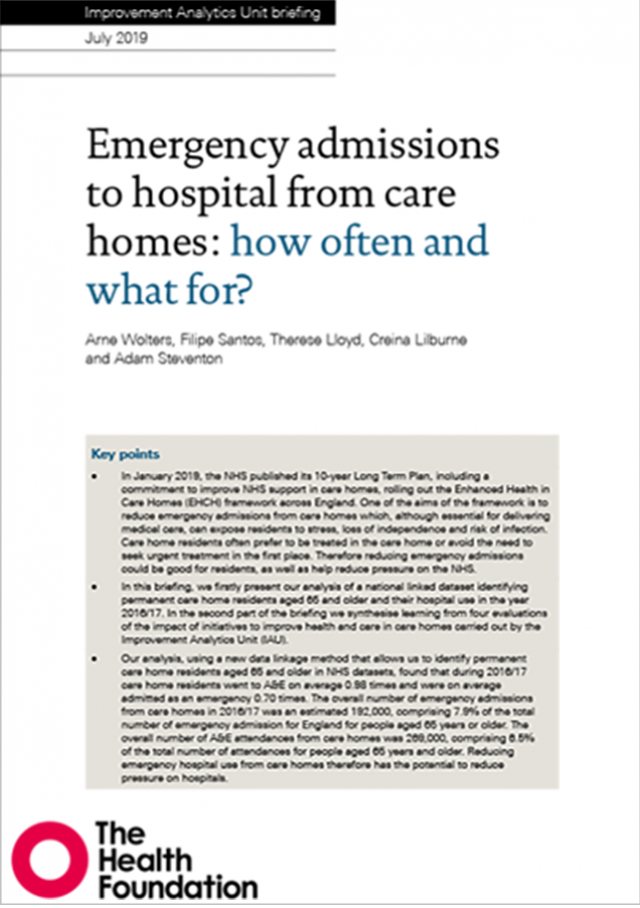Emergency admissions to hospital from care homes: how often and what for?
July 2019

Key points
- Analysis of a national linked dataset identifying permanent care home residents aged 65 and older and their hospital found that on average during 2016/17 care home residents went to A&E 0.98 times and were admitted as an emergency 0.70 times.
-
Emergency admissions were found to be particularly high in residential care homes compared with nursing care homes.
-
A large number of these emergency admissions may be avoidable: 41% were for conditions that are potentially manageable, treatable or preventable outside of a hospital setting, or that could have been caused by poor care or neglect.
-
Four evaluations of initiatives to improve health and care in care homes carried out by the Improvement Analytics Unit (IAU) in Rushcliffe, Sutton, Wakefield and Nottingham City show reductions in some measures of emergency hospital use for residents who received enhanced support.
-
There are key learnings from these IAU evaluations, including a greater potential to reduce the need for emergency admissions and A&E attendance in residential care homes and the benefit of coproduction between health care professionals and care homes.
Reducing emergency admissions from care homes has the potential to reduce pressure on hospitals. This is a significant national policy focus, as demonstrated by a strong commitment to improve support in care homes in the NHS Long Term Plan.
But to achieve change, we need to understand and monitor the quality of health care provided to residents, both to gauge the impact of national programmes and to help pinpoint areas of improvement. This briefing is split into two parts.
Read the full list of key points
First, the briefing shows the importance of having access to linked administrative datasets to provide evidence to support policy making and presents analysis of a national linked dataset identifying permanent care home residents aged 65 and older and their hospital use in 2016/17.
The second element of the briefing highlights learnings from focused evaluations by the Improvement Analytics Unit – a partnership between the Health Foundation and NHS England. The IAU analysed the impact of enhanced support initiatives associated with the NHS’s New Care Models programme in care homes in Rushcliffe, Sutton, Wakefield and Nottingham City. These initiatives included elements of the Enhanced Health in Care Homes framework, which will be rolled out as part of the NHS Long Term Plan.
Key lessons from these local evaluations:
- there is greater potential to reduce emergency admissions and A&E attendance in residential care homes compared with nursing homes,
- co-production between health care professionals and care homes is key to developing effective interventions,
- access to additional clinical input by named GPs and primary care services and/or multidisciplinary teams may be a key element in reducing emergency hospital use,
- and it is likely to take more than a year for changes to take effect – meaning it is important not to judge success too quickly.
Cite this publication
Further reading
Work with us
We look for talented and passionate individuals as everyone at the Health Foundation has an important role to play.
View current vacanciesThe Q community
Q is an initiative connecting people with improvement expertise across the UK.
Find out more


